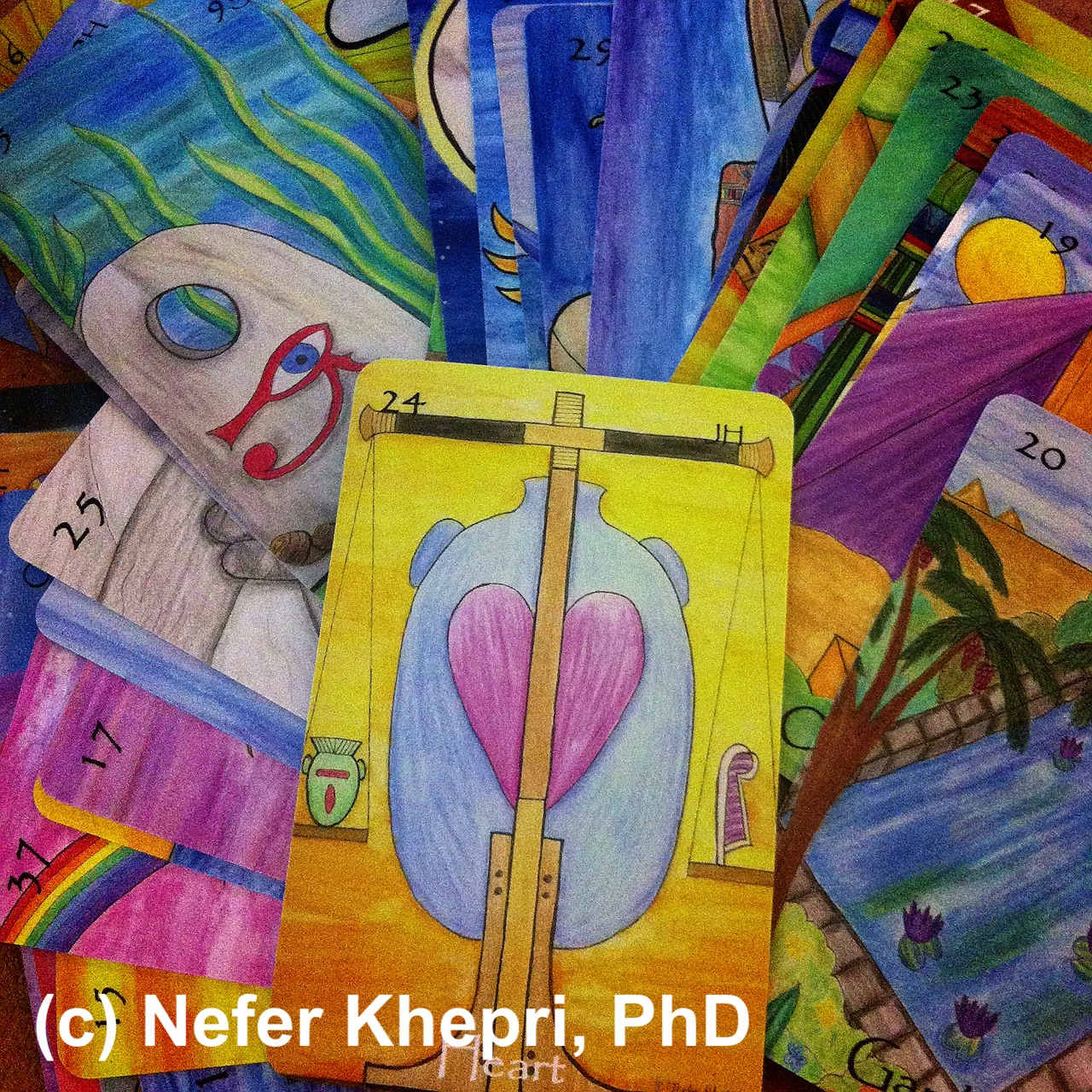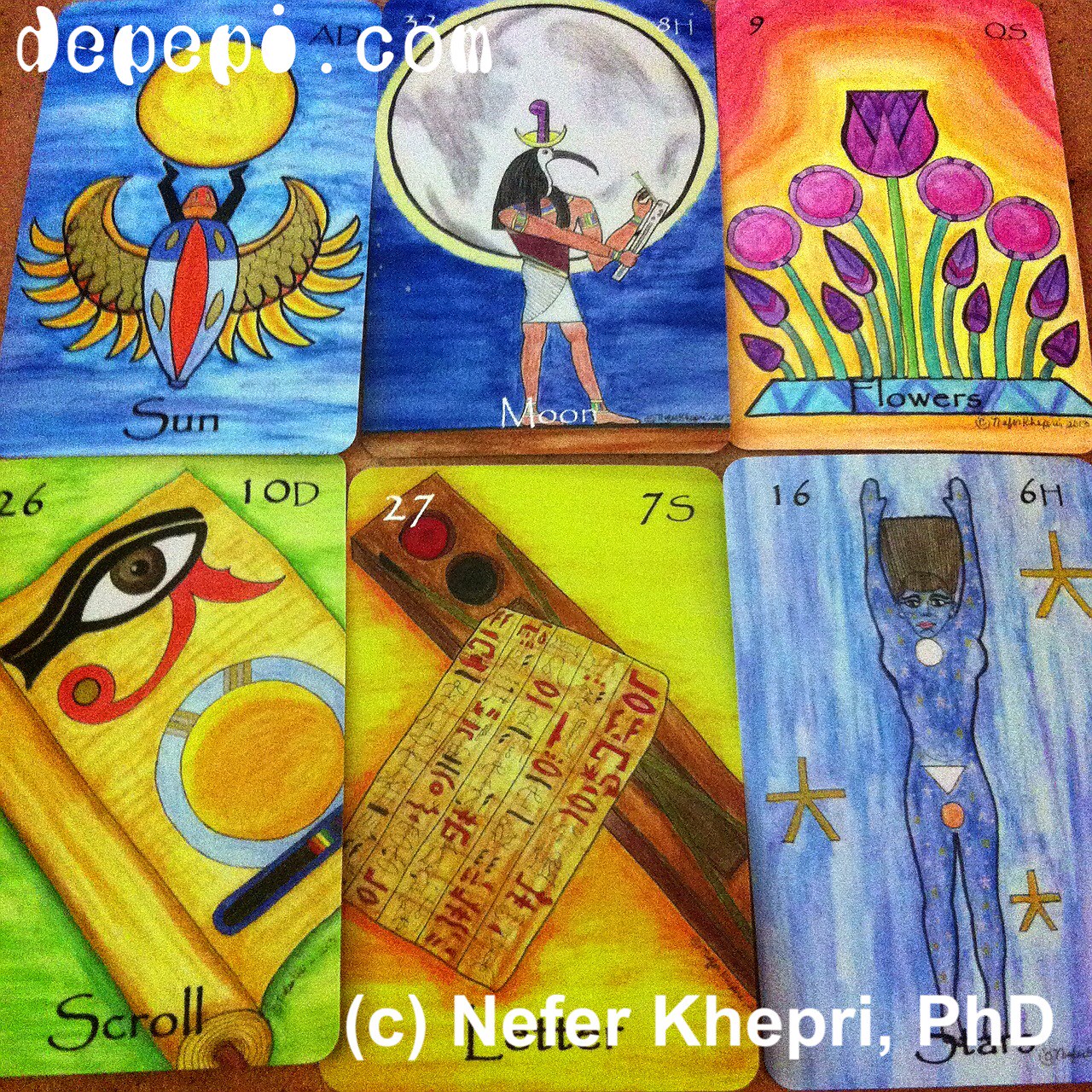Egyptian Lenormand, the Review & the Interview.

The Review
The Egyptian Lenormand is one of my favorite Lenormands. Created by Nefer Khepri, PhD, this is a jewel which is going to be published by Schiffer Books by the fall of 2014. However, you can still purchase the Indie version of it (you must run, because there are only a few left!).
This is a very colorful and happy Lenormand. If you like Egypt as I do, and if you are eager to learn something about it, this is your Lenormand. (Don’t worry: you’re provided with a wonderful pdf with exquisite explanations about the art, Egypt and the Lennies). Because it is based on Egypt, the art depicted in the cards is totally according to it. For example: the Rider is a guy dressed in white on a camel, behind the clover you can see a Pyramid, the coffin is actually a Sarcophagus, the whip and broom is a Crock and Flail (those o the Pharaohs), the child card has ancient Egyptian puppets on it, there’s a desert fox, a sacred cow instead of the bear, an Ibis instead of a Stork, an Obelisk instead of a Tower, a Scroll instead of a book, etc.
We have extra cards! The man and woman are portrayed here as the Pharaoh and the Priestess, but you can also choose the extra cards of God and Goddess if you wish to do so. There’s also a Cat with wings in the 37th card. You can either choose to use all the cards, or change some for others (dog for cat, Pharaoh for God, etc).
If you lay out all the cards on a table, you’ll be surprised. It’s colors are so vivid that it makes you automatically happy. And this is good, specially if you feel that you need to make a reading and it won’t be as positive. This is a great deck to use when you feel moody too 🙂 So, yes, if you want to feel happier, this is the deck to use.
The indie version is published with printer studio card stock, which is strong and smooth. It comes with a clear box and a black small bag to keep it safe.
One of the best parts of this deck is the message in one of the cards. This deck is dedicated to Nefer’s mother, Valentina Olga Gutierrez. It seems that this mother was really strong and did believe in Nefer’s Art. I like this memory card and message because it transmits not only the good memory of a mother, but also a lot of positives vibes and deep love.
Because the Indie version of it will become a collectors item, I do recommend you to try to get yours here. The commercial version will have some different cards, so, the Indie Deck is a unique item 🙂 I wouldn’t miss it!

The Interview
Pepi: How did you come up with the idea of creating an Egyptian Lenormand?
Nefer: I wished to create something I would love to create & enjoy using. I have a life-long love of all things ancient Egyptian so that was my first choice.
P: Was it difficult to relate Egyptian imaginary to the Lenormand one?
N: I thought it would be very difficult considering I was attempting to merge ancient Egyptian culture & spirituality with much more modern European culture & beliefs. However, it was fairly simple! I was amazed once I began my research how well the spiritual concepts, art, & architecture of the ancient Egyptians nicely fit in with the Lenormand system. This proves just how universal the Lenormand symbols really are, not just across Space, but Time as well.
My only issues were for the following cards: Whips, Bear, Storks, Tower, Book, & the Cross. That was quite a few. I made a list of all the symbols first & matched them as best I could with what I already knew about ancient Egypt. Then I researched the images and concepts behind the images for the aforementioned cards.
The Whips was a personal choice. I do not like the card, but I wanted another symbol that would convey arguments & possible violence, so I chose the Crook and Flail of the Pharaoh. It denotes his authority, but also his power over his people & his military might. The Egyptians were a warring group, so arguments and disagreements leading to battles is indicated by this image.
Regarding Bear, ancient Egypt had no bears. Instead of looking for a bear, I researched the meaning of the Bear card as it pertained to how the ancient Egyptians viewed the world. The Bear card represents strength, power, protection, – in other schools it can represent abundance and motherhood or a strong older female. I realized that the goddess Hathor represented all of these things, so I drew this card to depict Hathor in Her aspect the Sacred Cow in keeping with the animal theme for this particular card. The image is quite different, but the interpretation is identical.
Storks are not depicted in Egyptian art as far as I know, and I did not check to see if they were indigenous to the area. I wished to use another bird that looks very similar, but was of great spiritual significance to the ancient Egyptians so I chose the Ibis bird. The imagery is similar, and the interpretation remains the same.
The ancient Egyptians, except for the rumored tower at Alexandria, did not build towers as the Europeans have, so I had to find a substitute symbol. Again, I researched the meaning of the Tower card and then further researched those concepts as the ancient Egyptians viewed them. I came up with the Obelisk, a grand architectural feature whose only function was to convey the greatness of the Pharaoh and his exploits. The obelisk was a tool of propaganda and did not have any architectural function other than to act as a huge billboard. The inscriptions on obelisks speak of the Pharaoh’s achievements. Therefore, this symbol is closely tied to government and authority so it fit in with the Lenormand system. I renamed this card, “Obelisk.”
The ancient Egyptians did not have books in the same style as the Europeans. Their books were in two forms: as accordion-fold codices or as scrolls. So for the Book card I chose to depict it as a Scroll and I renamed the card “Scroll.”
The final card of the Lenormand system, The Cross, is not a part of Egyptian hieroglyphics or iconography. Due to the similarity between the ankh and Celtic cross, some of my Facebook friends suggested I draw an ankh for the Cross card. However, I knew the ankh to be a strongly positive symbol meaning Life, Breath, and Blessings, so it would not fit at all with the traditional meaning of the Cross. Once again, I researched concepts of the Cross card as they were thought of in ancient Egypt. The Cross represents extreme burdens, grief, guilt, and is the most negative card in the deck. I needed an ancient Egyptian symbol that would convey all of those meanings and realized immediately that the Djed Pillar would make a great substitution. The Djed Pillar represents the spine of the god Osiris, who was murdered & dismembered by his brother, Set. His body parts were scattered to the four winds & his mourning wife Isis had to travel the world to collect all the parts, then she tricked Ra into telling Her His true name, which gave Her power over Him to get from Ra His power to raise the dead. She then resurrected her beloved husband & Osiris then became the god of the Underworld,known to the ancient Egyptians as the Duat. So, in my deck, the Djed Pillar represents all the things represented by the traditional Cross card, with the additional meaning of extreme betrayal since Osiris was killed by his own brother.
P: Which is your favorite card? Why?
N: That’s easy. It’s the Sun. Why? This is a depiction of the beetle aspect of the god, Khepera, who was responsible for rolling the sun across the sky every single day. Khepera is also my namesake, with my last name being Khepri, which is a derivative of Khepera & means “morning sun,” or “rising sun.” I also love bright colors and love the colors of this card.
P: Which is the layout you think better fits your gorgeous deck?
N: My deck works well in all traditional Lenormand layouts. I love seeing it in a Square of 9 because you can see the interplay between the cards very easily within that layout. However, I also love seeing them laid out in the Grand Tableau. The cards all work & look very well together. They present a cohesive system that is true to both traditional Lenormand and ancient Egyptian concepts, art, and spirituality.
P: Any advices for readers?
N: My advice to readers is this: Keep an open mind. That is of paramount importance. Also, in collecting decks, focus on those you find artistically pleasing. You won’t use a deck if you don’t think it looks nice, so don’t buy the hot new deck if there’s something about the art you don’t like. Beauty is in the eye of the beholder, so find decks that appeal to you and they will become great tools to help you increase your powers of intuition and card interpretation.
—
From the original post. You can find it here.

Reblogged this on Magickal-Musings's Blog and commented:
Thank you very much to Pepi Valderrama for a wonderful review of my deck, “The Egyptian Lenormand,” that I self-published in February, 2013. I still have signed & numbered copies available & my deck will be published by Schiffer Books in the fall of 2014.